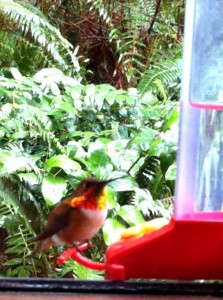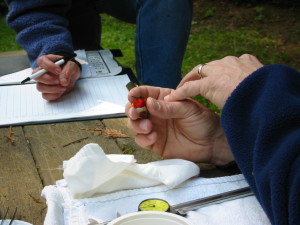We have much more to do and your continued support is needed now more than ever.
Ruhu’s return to the Pacific Northwest

For twenty-two years I have lived on a small island in the middle of Puget Sound and every year have put out at least one hummingbird feeder. As my fascination and interest grew about these tiny powerhouses, that number grew to nine. Yes, nine hummingbird feeders in one yard. Every year.
Now, I know that sounds a bit over the top but here’s the thing: Rufous hummingbirds are very, VERY territorial about their feeders and flower patches! Any time the males aren’t feeding or pursuing trysts with the females that arrive slightly after they do, they’re fighting to defend “their” flowers and feeders. So it became important to spread several feeders out around the yard and on opposite sides of the house. This allowed the battles to cease long enough for anyone to eat and to allow the females a chance at a feeder without getting chased off by the same guy who, just minutes ago, was courting and dancing for her like she was the most important thing in the universe.
Weighing in at barely 4 grams, adult Ruhu’s spread their winters in Mexico and migrate north with the advance of spring very often returning to the place of their birth, which can be anywhere from northern coastal California to Southestern Alaska. On my island, that timing falls remarkably in line with the Spring Equinox and, not coincidentally, right as the first salmonberry flowers open. By summer solstice, the males have left the island for flowers in higher elevations and points east and south. The females and young linger another few weeks before packing up and following dad out of town.
Catch, weigh, measure and release

It seems the Ruhu’s, along with other hummingbirds, had seen their populations plummet as suitable breeding and feeding habitat has been displaced by clearcutting, urban sprawl and other development. Pesticides and other yard chemicals are suspect causes as well.
Turns out that Ruhu’s have incredible memory; they will often return to the same flower patch or feeder they were raised on, year after year. I had suspected this a year or two earlier when, on an early spring day a male showed up while I was gardening and began buzzing around one particular spot by my living room window. It took me a few moments to realize that he was looking for (more like demanding) the feeder that hangs there every year in the same place; the feeder I had not put out yet. I dropped everything and ran inside to clean, fill and place that and the other feeders as quickly as I could!
Attracting Ruhu’s to your backyard
Want to attract Ruhu’s to your own backyard? You have to make a small commitment to it, as feeders need to be kept clean and free of mold or bugs. As the weather warms, the feed can go bad quickly so you have to be prepared to change it as soon as it gets cloudy. And please, avoid the prepared “nectar” that you can buy in most home and garden stores; the intense red dye is really hard on the little guys’ livers! Just mix up some sugar water in a 4 to 1 ratio. Dissolve it well, fill your feeders and keep the extra in your refrigerator. Don’t worry; once the Ruhu’s find your feeders you’re sure to use it up quickly.
With the Ruhu’s arrival this year I realized it’s high time I looked up those ornithologists to see what data they may have collected about the little tribe that returns to my yard every year. I’ll let you know what I learn.
Want to keep in touch with us here in the Seattle NWF office? Connect with us on Facebook for more information on global warming and other issues facing the nation’s wildlife and wild areas! You can also follow us on and Twitter.





















